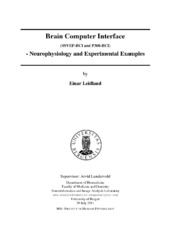Brain Computer Interface - Neurophysiology and Experimental Examples
Master thesis
Permanent lenke
https://hdl.handle.net/1956/5536Utgivelsesdato
2011-07-20Metadata
Vis full innførselSamlinger
Sammendrag
The last century has seen an incredible leap in human medicine, which has led to an increased life expectancy spanning over all age groups. Despite this development of modern medicine some patient groups do not have any proper treatment except for artificially prolonged life. One such group of patients suffer from neurodegenerative illnesses or spinal chord injuries resulting in a state of complete locked in syndrome (CLiS). Studies have shown that patients suffering from a milder type of locked in syndrome (LiS) highly value the ability to interact with their surroundings and that this interaction is important for their quality of life. The last couple of decades have on the other hand seen the emergence of a new promising technology in such context, namely the brain computer interface (BCI). This technology might give CLiS and LiS patients an improved ability to communicate with their surroundings and consequently improve their quality of life. BCI also give rise to other possibilities such as enhancing otherwise healthy people s general performance and introducing a new modality in gaming and entertainment. BCI represents a new way of communication for the brain, circumventing the normal output pathways of peripheral nerves and muscles. Instead alterations in brain signals are transmitted directly between the brain and a computer, where changes in the signals are detected and associated with a command or user intetion. These commands then let the user control electrical and mechanical devices connected to the system. This process is overseen and controlled through the operating protocol. In short a BCI system is made up of four essential parts: (i) signal acquisition, (ii) signal processing, (iii) command output, and (iv) an operating protocol. This thesis gives a extensive survey of the BCI field in a biomedical context and also highlights two BCI systems developed by Hoffmann et al. and Materka & Byczuk, respectively. Both systems are based on scalp EEG recordings needing very little training to operate. While Hoffmann and coworkers used P300 evoked potential to operate an environmental controller, Materka & Byczuk used steady state visual evoked potentials (SSVEP) to operate a spelling device. Even though BCI technology is mainly limited to research settings so far, it has great perspectives for the future - both for improving daily life in clinically targeted groups of patients, in cognitive neuroscience, and entertainment and gaming activities.
